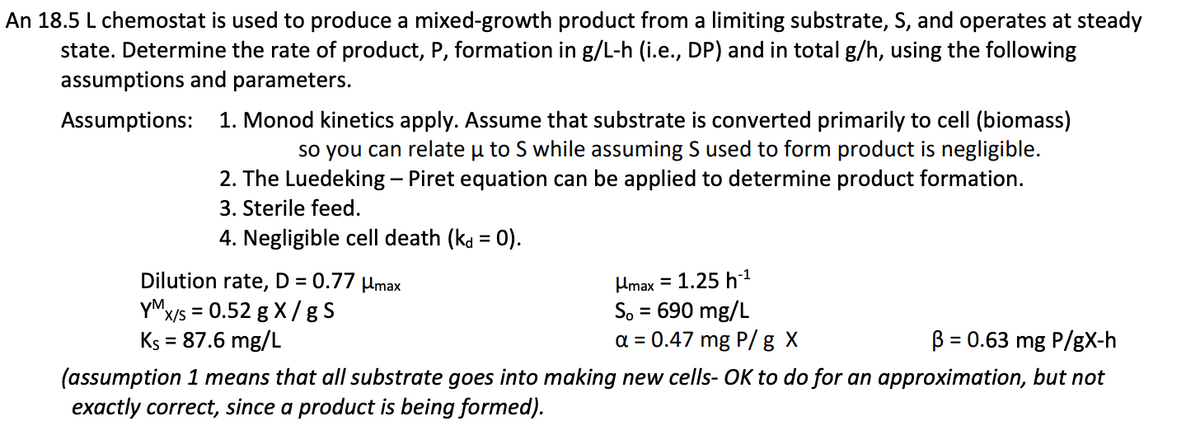An 18.5 L chemostat is used to produce a mixed-growth product from a limiting substrate, S, and operates at steady state. Determine the rate of product, P, formation in g/L-h (i.e., DP) and in total g/h, using the following assumptions and parameters. Assumptions: 1. Monod kinetics apply. Assume that substrate is converted primarily to cell (biomass) so you can relate μ to S while assuming S used to form product is negligible. 2. The Luedeking - Piret equation can be applied to determine product formation. 3. Sterile feed. 4. Negligible cell death (kd= 0). Dilution rate, D = 0.77 μmax YMX/s = 0.52 gx/gS Ks = 87.6 mg/L |max = 1.25 h So = 690 mg/L a = 0.47 mg P/g X B=0.63 mg P/gx-h (assumption 1 means that all substrate goes into making new cells- OK to do for an approximation, but not exactly correct, since a product is being formed).
An 18.5 L chemostat is used to produce a mixed-growth product from a limiting substrate, S, and operates at steady state. Determine the rate of product, P, formation in g/L-h (i.e., DP) and in total g/h, using the following assumptions and parameters. Assumptions: 1. Monod kinetics apply. Assume that substrate is converted primarily to cell (biomass) so you can relate μ to S while assuming S used to form product is negligible. 2. The Luedeking - Piret equation can be applied to determine product formation. 3. Sterile feed. 4. Negligible cell death (kd= 0). Dilution rate, D = 0.77 μmax YMX/s = 0.52 gx/gS Ks = 87.6 mg/L |max = 1.25 h So = 690 mg/L a = 0.47 mg P/g X B=0.63 mg P/gx-h (assumption 1 means that all substrate goes into making new cells- OK to do for an approximation, but not exactly correct, since a product is being formed).
Introduction to Chemical Engineering Thermodynamics
8th Edition
ISBN:9781259696527
Author:J.M. Smith Termodinamica en ingenieria quimica, Hendrick C Van Ness, Michael Abbott, Mark Swihart
Publisher:J.M. Smith Termodinamica en ingenieria quimica, Hendrick C Van Ness, Michael Abbott, Mark Swihart
Chapter1: Introduction
Section: Chapter Questions
Problem 1.1P
Related questions
Question

Transcribed Image Text:An 18.5 L chemostat is used to produce a mixed-growth product from a limiting substrate, S, and operates at steady
state. Determine the rate of product, P, formation in g/L-h (i.e., DP) and in total g/h, using the following
assumptions and parameters.
Assumptions:
1. Monod kinetics apply. Assume that substrate is converted primarily to cell (biomass)
so you can relate µ to S while assuming S used to form product is negligible.
2. The Luedeking - Piret equation can be applied to determine product formation.
3. Sterile feed.
4. Negligible cell death (kd = 0).
Dilution rate, D = 0.77 μmax
YM
x/s = 0.52 g X/gS
Umax = 1.25 h
So = 690 mg/L
a = 0.47 mg P/g X
Ks = = 87.6 mg/L
B = 0.63 mg P/gX-h
(assumption 1 means that all substrate goes into making new cells- OK to do for an approximation, but not
exactly correct, since a product is being formed).
Expert Solution
This question has been solved!
Explore an expertly crafted, step-by-step solution for a thorough understanding of key concepts.
Step by step
Solved in 3 steps with 11 images

Recommended textbooks for you

Introduction to Chemical Engineering Thermodynami…
Chemical Engineering
ISBN:
9781259696527
Author:
J.M. Smith Termodinamica en ingenieria quimica, Hendrick C Van Ness, Michael Abbott, Mark Swihart
Publisher:
McGraw-Hill Education

Elementary Principles of Chemical Processes, Bind…
Chemical Engineering
ISBN:
9781118431221
Author:
Richard M. Felder, Ronald W. Rousseau, Lisa G. Bullard
Publisher:
WILEY

Elements of Chemical Reaction Engineering (5th Ed…
Chemical Engineering
ISBN:
9780133887518
Author:
H. Scott Fogler
Publisher:
Prentice Hall

Introduction to Chemical Engineering Thermodynami…
Chemical Engineering
ISBN:
9781259696527
Author:
J.M. Smith Termodinamica en ingenieria quimica, Hendrick C Van Ness, Michael Abbott, Mark Swihart
Publisher:
McGraw-Hill Education

Elementary Principles of Chemical Processes, Bind…
Chemical Engineering
ISBN:
9781118431221
Author:
Richard M. Felder, Ronald W. Rousseau, Lisa G. Bullard
Publisher:
WILEY

Elements of Chemical Reaction Engineering (5th Ed…
Chemical Engineering
ISBN:
9780133887518
Author:
H. Scott Fogler
Publisher:
Prentice Hall


Industrial Plastics: Theory and Applications
Chemical Engineering
ISBN:
9781285061238
Author:
Lokensgard, Erik
Publisher:
Delmar Cengage Learning

Unit Operations of Chemical Engineering
Chemical Engineering
ISBN:
9780072848236
Author:
Warren McCabe, Julian C. Smith, Peter Harriott
Publisher:
McGraw-Hill Companies, The